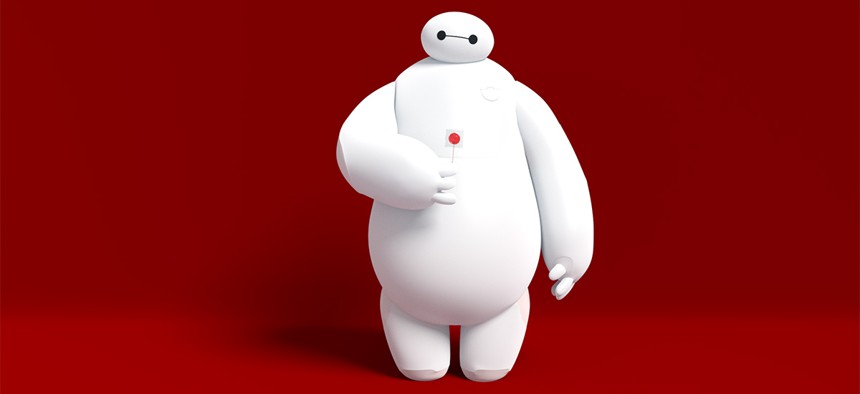Why the Future Needs Huggable Robots

The character Baymax, from the Disney film Big Hero 6, is a soft and cuddly robot designed to help people. Flickr user Dragos Ionita
The distance between people and machines—the fact that robots aren’t more snuggly—poses a real problem for the future of robotics.
Robots have a reputation for being made of cold, hard, metal. It’s an image that’s been reinforced by Rosie Jetson, C-3PO, Marvin, Bender and any number of humanoid machines in popular culture.
Plenty of real-world robots look this way, too. With steel torsos and rigid limbs, most robots aren’t exactly huggable. Put it this way: Imagine you see Atlas, the rugged humanoid robot made by Boston Dynamics, crunching its way down the sidewalk and coming toward you.
You’re probably going to be careful about approaching that thing, right? Which is a good call. But the distance between people and machines—the fact that robots aren’t more snuggly—poses a real problem for the future of robotics.
“I just do not see a way to have a Terminator-style robot take care of people,” said Christopher Atkeson, a roboticist at Carnegie Mellon. “If you’re going to interact with soft human beings, you—mechanically—also should be lightweight or at least soft.”
Atkeson has given this matter a good deal of thought. He and his colleagues advised filmmakers as they were developing the concept for Baymax, the giant doughy robot in the 2014 animated film "Big Hero 6." In Marvel comic books, Baymax was depicted as a shapeshifting robot. Its original form was a sort of Hulk-Godzilla mashup: a tall, jacked reptile with huge claws. For the Disney adaptation, filmmakers wanted to reinvent Baymax.
“They wanted something completely different,” Atkeson told me. “They didn’t want to do another Terminator, or Transformer, or a Short Circuit.”
So Atkeson showed the filmmakers an example of a robot one of his graduate students had built. It was an inflatable arm that could feed people, help them wipe their faces, comb their hair.
“When the director came around, I said, ‘Look, I’m tired of movies in which robots kill people,’” Atkeson said. “And, I said, ‘If robots are really going to interact with people, it needs to be at least lightweight—and ideally soft and compliant.’”
Soft robots can often do things that hard robots can’t. They can grip, jump and snake through narrow spaces in unique ways. This doesn’t mean soft robots will make hard robots obsolete. Many tasks require more durable robots. It just means that humans will be able to interact more safely with pillowy robots—whether the machines are designed to be companions or caretakers. If an inflatable robot accidentally smacks a person in the face, for example, they probably won’t be seriously injured.
The nascent field of soft robotics has emerged from this principle: Human-robot interaction is often better for humans if the robots are a little squishy, like us. Not because fluffy robots are more approachable or nonthreatening, but because form follows function.
“It’s a mechanical issue,” Atkeson said. “You’re not going to brush your teeth with a bulldozer. That would be a mechanical mismatch. And if you can never touch your buddy, it’s a problem. We’re touchers, all of us.”





